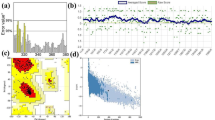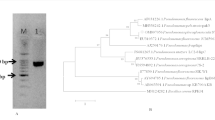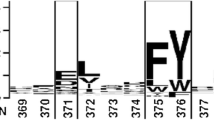Abstract
In addition to their physiological importance, microbial lipases, like staphylococcal ones, are of considerable commercial interest for biotechnological applications such as detergents, food production, and pharmaceuticals and industrial synthesis of fine chemicals. The gene encoding the extracellular lipase of Staphylococcus simulans (SSL) was subcloned in the pET-14b expression vector and expressed in Esherichia coli BL21 (DE3). The wild-type SSL was expressed as amino terminal His6-tagged recombinant protein. One-step purification of the recombinant lipase was achieved with nickel metal affinity column. The purified His-tagged SSL (His6-SSL) is able to hydrolyse triacylglycerols without chain length selectivity. The major differences among lipases are reflected in their chemical specificity in the hydrolysis of peculiar ester bonds, and their respective capacity to hydrolyse substrates having different physico-chemical properties. It has been proposed, using homology alignment, that the region around the residue 290 of Staphylococcus hyicus lipase could be involved in the selection of the substrate. To evaluate the importance of this environment, the residue Asp290 of Staphylococcus simulans lipase was mutated to Ala using site-directed mutagenesis. The mutant expression plasmid was also overexpressed in Esherichia coli and purified with a nickel metal affinity column. The substitution of Asp290 by Ala was accompanied by a significant shift of the acyl-chain length specificity of the mutant towards short chain fatty acid esters. Kinetic studies of wild-type SSL and its mutant D290A were carried out, and show essentially that the catalytic efficiency (k cat /K M ) of the mutant was affected. Our results confirmed that Asp290 is important for the chain length selectivity and catalytic efficiency of Staphylococcus simulans lipase.





Similar content being viewed by others
Abbreviations
- SSL:
-
Staphylococcus simulans lipase
- SAL NCTC 8530:
-
Staphylococcus aureus NCTC 8530 lipase
- SAL PS54:
-
Staphylococcus aureus PS54 lipase
- SEL:
-
Staphylococcus epidermis lipase
- SHL:
-
Staphylococcus hyicus lipase
- LB:
-
Luria–Bertani
- IPTG:
-
Isopropyl-β-d-thiogalactopyranoside
- NTA:
-
Nitrilotriacetate
- BSA:
-
Bovine serum albumin
- DTT:
-
Dithiothreitol
- EDTA:
-
Ethylene Diamine Tetraacetic Acid
- PC:
-
Phosphatidylcholine
- EGTA:
-
Ethylene Glycol-bis (β-aminoethyl Ether) N,N,N′,N′-Tetraacetic Acid
- NaDC:
-
Sodium deoxycholate
- NaTDC:
-
Sodium taurodeoxycholate
- DrPLA2 :
-
Dromedary pancreatic phospholipase A2
- PCR:
-
Polymerase chain reaction
- SDS/PAGE:
-
Sodium dodecyl sulfate/polyacrylamide gel electrophoresis
- TC4 :
-
Tributyrin (tributyryl glycerol)
- TC18 :
-
Triolein (trioleyl glycerol)
References
Ben Bacha, A., Gargouri, Y., Bezzine, S., & Mejdoub, H. (2006). Purification and characterization of phospholipase A2 from dromedary pancreas. Biochimica et Biophysica Acta, 1760, 1202–1209.
Birnboim, H. C. (1983). A rapid alkaline extraction method for the isolation of plasmid DNA. Methods in Enzymology, 100, 243–255.
Bradford, M. M. (1976). A rapid and sensitive method for the quantitation of quantities of protein utilising the principle of protein-dye binding. Analytical Biochemistry, 72, 248–254.
Christensson, B., Fehrenbach, F. J., & Hedstrom, S. A. (1985). A new serological assay for Staphylococcus aureus infections: detection of IgG antibodies to S. aureus lipase with an enzyme-linked immunosorbent assay. Journal of Infectious Disease, 152, 286–292.
Davies, M. E. (1954). A study of the diffusible lipase produced by staphylococci and of its immunological activity. Journal of General Microbiology, 11, 37–44.
Egloff, M.-P., Ransac, S., Marguet, F., Rogalska, E., van Tilbeurgh, H., Buono, G., Cambillau, C., & Verger, R. (1995). Enzymes lipolytiques et lipolyse. Les lipases: cinétiques, spécificités et aspect structuraux. OCL, 2, 52–67.
Gargouri, Y., Ben Salah, A., Douchet, I., & Verger, R. (1995). Kinetic behaviour of pancreatic lipase in five species using emulsion and monomolecular films of synthetic glycerides. Biochimica et Biophysica Acta, 1257, 223–229.
Gargouri, Y., Moreau, H., & Verger, R. (1989). Gastric lipases: biochemical and physiological studies. Biochimica et Biophysica Acta, 1006, 255–271.
Gargouri, Y., Julien, R., Sugihara, A., Verger, R., & Sarda, L. (1984). Inhibition of pancreatic and microbial lipases by proteins. Biochimica et Biophysica Acta, 795, 326–331.
Gargouri, Y., Pieroni, G., Rivière, C., Sugihara, A., Sarda, L., Verger, R. (1985). Inhibition of lipases by proteins. A kinetic study with dicaprin monolayers. Journal of Biological Chemistry, 260, 2268–2273.
Jaeger, K. E., Dijkstra, B. W., & Reetz, M. T. (1999). Bacterial biocatalysts: molecular biology, three-dimentional structures, and biotechnological applications of lipases. Annual Review of Microbiology, 53, 315–351.
Jaeger, K., & Reetz, M. (1998). Microbial lipases form versatile tools for biotechnology. Trends in Biotechnology, 16, 396–403.
Jürgens, D., & Huser, H. (1981). Large-scale purification of Staphylococcal lipase by interaction chromatography. Journal of Chromatography, 216, 295–301.
Jürgens, D., Huser, H., & Fehrenbach, F. J. (1981). Purification and characterisation of Staphylococcus aureus lipase. FEMS Microbiology Letters, 12, 195–199.
Kloos, W. E., Schleifer, K., & Götz, F. (1991). The genus Staphylococcus. In A. Balows, H. G. Trüper, M. Dworkin, W. Harder, & K. H. Schleifer (Eds.), The prokaryotes (pp. 1369–1420). NY: Springer-Verlag.
Kötting, J., Jürgens, D., & Huser, H. (1983). Separation and characterisation of two lipases from Staphylococcus aureus (ten 5). Journal of Chromatography, 281, 253–261.
Laemmli, U.K. (1970). Cleavage of structural protein during the assembly of the head of bacteriophage T4. Nature, 227, 680–685.
Lee, C.Y., & Iandolo, J.J. (1986). Lysogenic conversion of Staphylococcal lipase is caused by insertion of the bacteriophage L54a genome into the lipase structural gene. Journal of Bacteriology, 166, 385–391.
Marmur, J. (1961). A procedure for the isolation of deoxyribonucleic acid from microorganisms. Journal of Molecular Biology, 3, 208–218.
Mosbah, H., Sayari, A., Bezzine, S., & Gargouri Y. (2006). Expression, purification, and characterization of His-tagged Staphylococcus xylosus lipase wild-type and its mutant Asp290Ala. Protein Express. Purification, 47, 516–523.
Oh, B., Kim, H., Lee, J., Kang, S., & Oh, T. (1999) Staphylococcus haemolyticus lipase: biochemical properties, substrate specificity and gene cloning. FEMS Microbiology Letter, 179, 385–392.
Pablo, G., Hammons, A., Bradley, S., & Fulton, J. E. (1974). Characterisation of the extracellular lipases from Corynebacterium acnes and Staphylococcus epidermidis. The Journal of investigative Dermatology, 63, 231–238.
Pieroni, G., Gargouri, Y., Sarda, L., & Verger, R. (1990). Interactions of lipases with lipid monolayers. Facts and Questions. Advances in Colloid and Interface Science, 32, 341–378.
Rathelot, J., Julien, R., Canioni, P., Coeroli, C., & Sarda, L. (1975). Studies on the effect of bile salt and colipase on enzymatic lipolysis. Improvement method for the determination of pancreatic lipase and colipase. Biochimie, 57, 1117–1122.
Rollof, J., Braconier, J. H., Soderstrom, C., & Nilsson-Ehle, P. (1988). Interference of Staphylococcus aureus lipase with human granulocyte function. European Journal of Clinical Microbiology & Infectious Diseases, 7, 505–510.
Rosenstein, R., & Gotz, F. (2000). Staphylococcal lipases: biochemical and molecular characterisation. Biochimie, 82, 1005–10014.
Sayari, A., Agrebi, N., Jaoua, S., & Gargouri, Y. (2001). Biochemical and molecular characterization of Staphylococcus simulans lipase. Biochimie, 83, 863–871.
Sayari, A., Verger, R., & Gargouri, Y. (2002) Comparative kinetic studies of two staphylococcal lipases using the monomolecular film technique. Journal of Biochemistry and Molecular Biology, 34, 457–462.
Simons, J. W. F. A., Adams, H., Cox, R. C., Dekker, N., Gotz, F., Slotboom, A. J., & Verheij, H. M. (1996). The lipase from Staphylococcus aureus. Expression in Escherischia coli, large-scale purification and comparison of substrate specificity to Staphylococcus hyicus lipase. Eur. Journal of Biochemistry, 242, 760–769.
Simons, J. W. F. A., van Kampen, M. D., Ubarretxena-Belandia, I., Cox, R. C., Alves dos Santos, C. M., Egmond, M. R., & Verheij, H. M. (1999) Identification of a calcium binding site in Staphylococcus hyicus lipase: Generation of calcium-independent variants. Biochemistry, 38, 2–10.
Tysky, S., Hryniewicz, W., & Jeljaszewicz, J. (1983). Purification and properties of the staphylococcal extracellular lipase. Biochimica et Biophysica Acta, 749, 312–317.
Van Kampen, M. D., Dekker, N., Egmond, M. R., & Verheij, H. M. (1998). Substrate specificity of Staphylococcus hyicus lipase and Staphylococcus aureus lipase as studied by in vivo chimeragenesis. Biochemistry, 37, 3459–3466.
Weld, J. T., & O’Leray, W. M. (1963). Events associated with the development of lipid plaques on plasma agar. Nature, 199, 510–511.
Acknowledgements
This work was supported financially by « Ministère de la recherche scientifique, de la technologie et de développement des compétences—Tunisia » through a grant to « Laboratoire de Biochimie et de Génie Enzymatique des Lipases—ENIS ».
Author information
Authors and Affiliations
Corresponding author
Rights and permissions
About this article
Cite this article
Sayari, A., Mosbah, H. & Gargouri, Y. Importance of the residue Asp 290 on chain length selectivity and catalytic efficiency of recombinant Staphylococcus simulans lipase expressed in E. coli . Mol Biotechnol 36, 14–22 (2007). https://doi.org/10.1007/s12033-007-0008-2
Received:
Revised:
Accepted:
Published:
Issue Date:
DOI: https://doi.org/10.1007/s12033-007-0008-2




